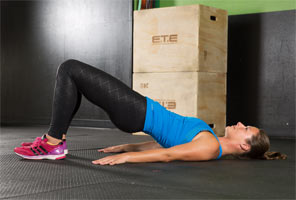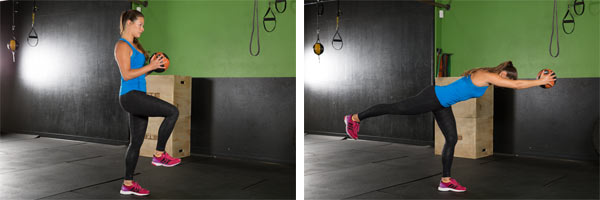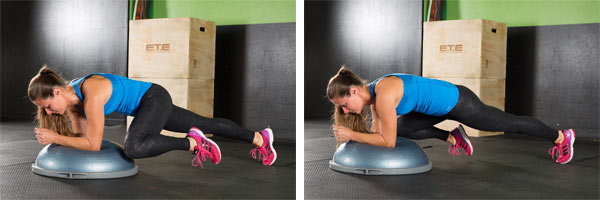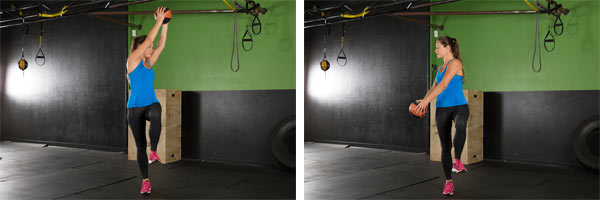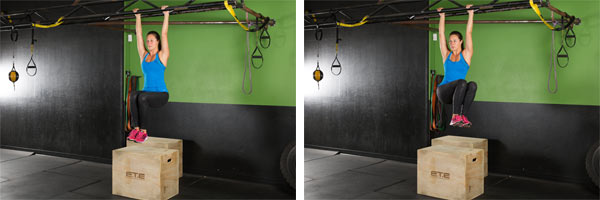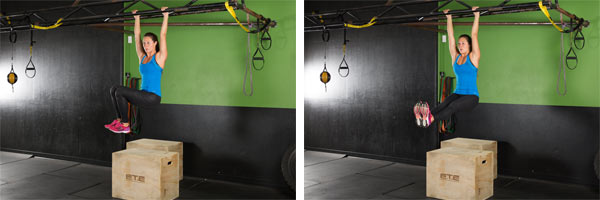The
word “core” is thrown around so often in today’s movement classes, it’s
almost lost all meaning. The core doesn’t mean just your abdominals or
the front of the body. It means the entire trunk, front and back,
including the hips.
The goal in this series of exercises is to help train and create core
stiffness, which means the muscles of the core adequately support the
spine. Dr. Stuart McGill, a leading back and spine researcher, puts it
this way: “Core stiffness is essential for injury prevention. Core
stiffness is essential for performance enhancement. Core stiffness is
not optimized in body-building exercises. Core stiffness requires
dedicated training.”
The plank is one of the best ways to train for core stiffness. Be
sure your clients have mastered the basic plank, whether from their feet
or knees, before moving on to the following variations featuring the
TRX Suspension Trainer.
TRX Rotational Ward
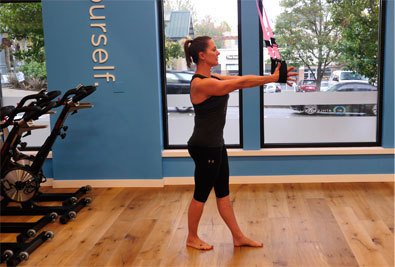
Adjust the Suspension Trainer (ST) to fully lengthened and stand with
the right side of the body to the anchor. With the arms extended from
the chest and the hands inside of the foot cradles, line the elbows up
to the anchor point. Stand in an offset position, with the right leg in
front of the left. Build the plank by corkscrewing the shoulders,
feeling the lats engage. Push down into the floor for full lower-body
engagement, and squeeze the legs together. With the shoulders packed,
pull the ST taught, keeping tension throughout the body and the ST. Keep
the eyes on the horizon, and be mindful if form begins to suffer.
Remind your client that he or she has to stay intentional on the plank
position. This becomes a game changer for each exercise.
TRX Plank (hands or forearms)
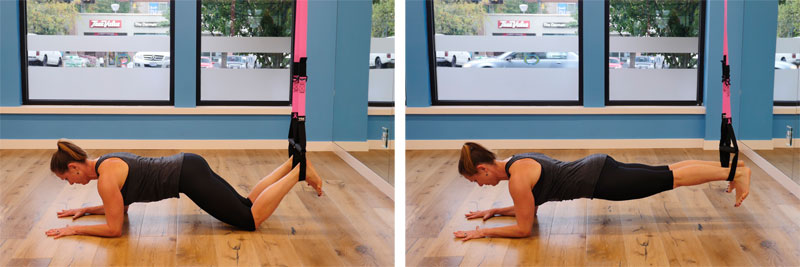
Adjust the ST to mid-calf. Face away from the anchor, place the toes
in the foot cradles and assume a table-top position with the hands under
the shoulders. Corkscrew the shoulders until a solid packing is felt
around the shoulder girdle. Keeping the torso rigid, press the feet into
the foot cradles and lift up into a plank position. Keep the feet
flexed and the glutes, legs, torso and shoulders fully engaged. Hold the
plank for 8 to 10 seconds. Continue as long as a perfect plank can be
maintained. Rest and repeat, if desired.
TRX Side Plank (hands or forearms)
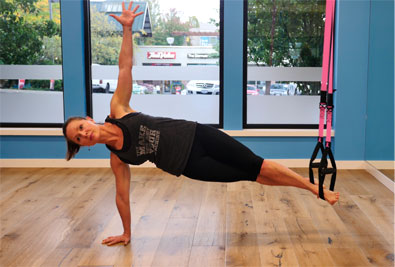
Adjust the ST to mid-calf and lie on one side with the hip in line
with the anchor. The leg closest to the anchor is right in front of the
back leg. Place the elbow or hand under the shoulder. Corkscrew the
shoulder to create a shoulder pack. Flex the feet and squeeze them
together; lift up by pressing into the foot cradles. Look straight ahead
and hold the plank for 8 to 10 seconds; rest, reset and lift back up.
Continue as long as a perfect plank can be maintained. Rest and repeat
while lying on the other side.
Side-angle Plank (opposite arm extended)

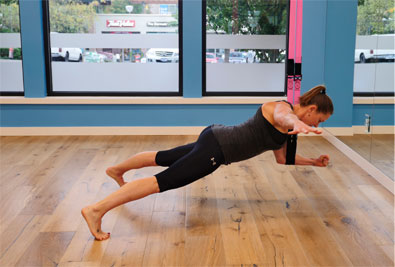
Adjust the ST to mid-calf and lie on the floor while facing the
anchor point. Set the right forearm into both foot cradles. Use the left
arm to help set up the plank and stabilize the position. Corkscrew the
shoulders to pack and spread the legs a little wider than shoulder-width
apart. Press down into the foot cradles; don’t allow the torso to
rotate. Extend the left arm to shoulder height. Hold this plank while
lifting and tapping the left arm to the floor. Repeat on the other side.
Forearm Plank (leg elevated)
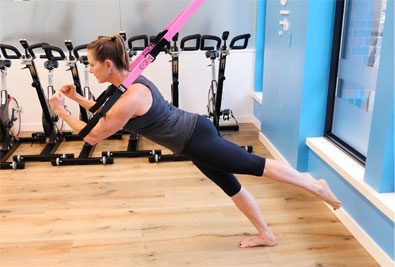
Adjust the ST to fully lengthened and stand facing away from the
anchor. Place the forearms into the foot cradles, keeping the elbows in
line with the shoulders. Corkscrew the shoulders to create a pack, and
keep the ribs pressing down toward the hips. Create a rigid torso and
step toward the anchor to provide enough load to be challenged yet still
maintain a perfect plank.
Single-Leg Plank with Alternating Elbow Tap
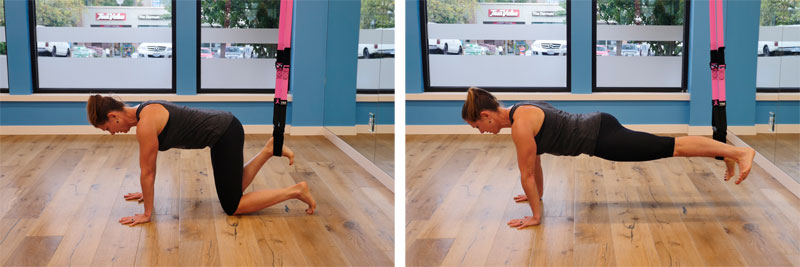
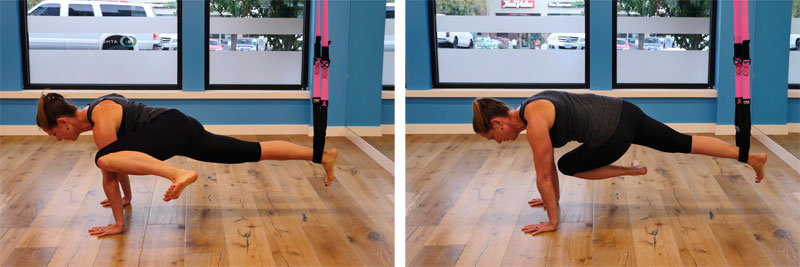
Adjust the ST to mid-calf. Face away from the anchor and lie on the
floor with the hands beneath the shoulders; place the right foot in the
foot cradle. Corkscrew the shoulders to pack them. From a table-top
position, press down into the foot cradles and assume a plank position.
Draw the right knee to the right elbow and hold for a beat. Keeping the
knee high, rotate to the left elbow and hold a beat. Return to the right
elbow. Continue as long as a proper plank can be maintained and then
repeat with the left knee.
TRX Handstand
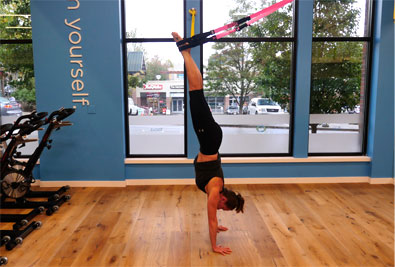
Adjust the ST to mid-calf and place the handles in single-handle mode. Stand facing away from the anchor and place the right foot in the foot cradles. Walk the hands away from the anchor until the ST is very taut. Continue walking back until the right leg is extended. Press the floor away, keep the shoulders set and lift the left leg to meet the right. While in this handstand position, think about keeping the shoulders away from the ears and tension in the core. Hold as long as a proper plank can be maintained and repeat with the other leg.
Source : ACE Elizabeth Andrews










